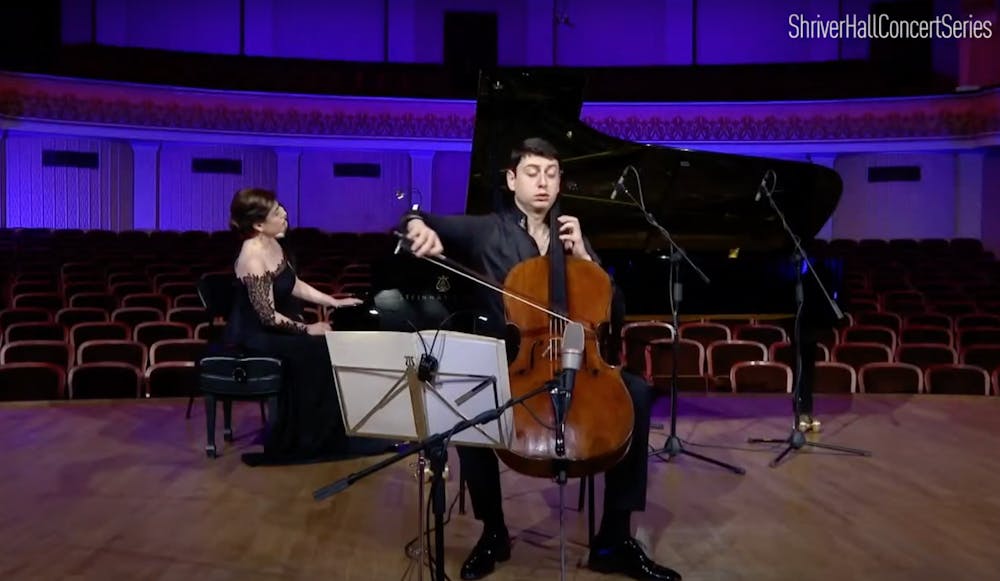Cellist Narek Hakhnazaryan and pianist Armine Grigoryan performed in the Shriver Hall Concert Series on March 14. Their performances were prerecorded at Aram Khachatryan Concert Hall in Yerevan, Armenia. The recording was available on demand through Sunday, March 21.
The cellist’s program consisted of five pieces and began with Robert Schumann’s Adagio and Allegro, Op.70. A soft and mellow tone rang through the screen as the cello and piano sounds were perfectly balanced. The piece was comforting and made me feel like I was walking in a dreamy flower garden.
The swift transition to the Allegro was surprising, and despite the fast-paced nature of the section, Hakhnazaryan’s vibrato gave shape to the melody throughout the music. His ability to not compromise melodic phrasing in the faster parts of the piece spoke greatly to his technical skills as a cellist.
Upon ending Schumann’s piece, Hakhnazaryan moved onto the second piece of the program, Ludwig Van Beethoven’s Seven variations on “Bei Mannern, welche Liebe fuhlen,” WoO 46.
Hakhnazaryan started the piece with feather-like strokes of the bow, giving the piece a light and airy start. Compared to Schumann’s piece, the cello and piano melodies seemed to talk to each other more, giving the impression of two distinct voices. This aspect of the piece made it conversational and demonstrated the cellist and pianist’s smooth, harmonious cooperation.
My favorite part of the program was the third piece, Cesar Franck’s Sonata in A major for Violin and Piano. I loved it partly because I had performed a movement of it before and partly because it has a very moving emotional element to it. This piece fascinates me because a romantic story is told purely through musical notes without the need for words.
The first movement sounded like someone calling out to another individual. This characteristic draws the audience in by making them curious. There was more variation in tempo for the second movement, which seemed to reflect intense passion. Grigoryan’s accompaniment added to the emotional rollercoaster throughout the second movement with heavy scales that ascended and descended continuously.
The ending of the second movement was as impressive as its beginning, with a series of short tremolos leading to the ending chord. Hakhnazaryan’s playing of the third movement conveyed some kind of emotional challenge that was felt by the individual in the musical story, while the fourth movement had a pure and bright sound, which signaled a happy resolution to the story.
The next two pieces of the program were “Nocturne” by Edvard Baghdasaryan and “Impromptu” by Alexander Grigori Arutiunian. Like Hakhnazaryan and Grigoryan, both composers are Armenian.
“Nocturne” was very calming and similar to Franck’s Sonata in A major for Violin and Piano in the sense that there was a voice calling for something. I found this piece special because there was a repeated melody that sounded uniquely different every time Hakhnazaryan played it throughout the piece.
Hakhnazaryan performed a surprising entrance for “Impromptu,“ the last piece of his program, by introducing a joyful and upbeat rhythm. To me, it sounded like the music was encouraging people to dance. This exciting beginning was followed by a more serious section. I thought the third part of the piece was the most intriguing; Hakhnazaryan played his cello with harsh strokes before transitioning into pizzicato, a special plucking technique used by string instrumentalists. A great variety of these technical skills was displayed by the cellist, and I was in awe by the end.
After the program, there was a recorded conversation with cellist Hakhnazaryan, who had previously performed in 2013’s Shriver Hall Discovery Series. During the interview, he hoped for improvement with the pandemic so that everyone could resume enjoying live concerts. He emphasized that live performances allow for an exchange of energy and emotion between musicians and audiences.
When asked what music he would recommend, Hakhnazaryan began with how he felt responsible for introducing his native Armenian culture and music to an international audience. He recommended that people start with listening to Arutiunian’s famous Trumpet Concerto in A flat major. He also encouraged Baghdasaryan’s music, though he is less known than Arutiunian.
Hakhnazaryan described Baghdasaryan’s “Nocturne,” which he performed during the concert, as one of the most precious pieces in his repertoire.
“I grew up listening to that piece performed by my father, who is a violinist and professor in Armenia and Moscow conservatories,” he said.
He also explained how he chose the pieces for his program. Hakhnazaryan strives to defy the stereotype of the cello as an instrument that must perform in the lower registers. He believes that the cello is one of the most versatile string instruments. Hakhnazaryan also explained that he simply chose pieces that most resonated with him.
“I was just thinking what should I share with the audience — what I feel like playing in this moment of my life, what I feel connected to,” he said.
I was touched when Hakhnazaryan said that he creates programs that are as diverse as possible so that anyone in the audience can discover a favorite piece. He also expressed his desire to share more Armenian music to citizens of the Baltimore community.
One thing I noticed about the Shriver Hall Concert series was the provision of the artist conversation after the concert. Normally in person, I would only go to the performance and not attend the interview. However, I do encourage people to attend these interviews because they provides insight into the artist’s motive for choosing their specific program. Above all, they remind us that the musicians are also humans like us and not distant figures who are unapproachable.





